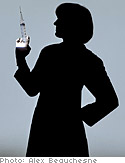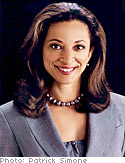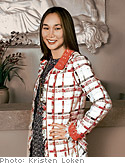
Four women who have unlimited access to top dermatologists and plastic surgeons (because they are top dermatologists and plastic surgeons) share their expertise.
Find out what they're doing for their own skin, what they wish they had done, what's way too risky for them, which products they swear by, which much-touted treatment is expensive baloney (they don't all agree). A report from the cutting (and jabbing and zapping) edge of skincare.
Get the facts about Botox and brow lifts from the dermatology dictionary.
Find out what they're doing for their own skin, what they wish they had done, what's way too risky for them, which products they swear by, which much-touted treatment is expensive baloney (they don't all agree). A report from the cutting (and jabbing and zapping) edge of skincare.
Get the facts about Botox and brow lifts from the dermatology dictionary.

What she's doing to her skin right now: "I do Botox every few months in my forehead, but not too often. I don't have a lot of deep lines, and I don't want to get rid of all my fine lines, but Botox gives me a brow lift effect. And I think it has prevented the lines in my forehead from getting really deep. I also do Restylane, one of the hyaluronic acid fillers, in my nasolabial folds (the lines from my nose to my mouth) and the lines around my lips. About once a year, I inject it in the hollows under my eyes as well—and that has given me the most dramatic results of anything else I've tried. I was starting to look tired all the time, and now I look, and actually feel, more rested."
What she might do to her skin one day: "More fillers. I'm starting to lose fullness in my face, so I'd consider doing a fat transfer or a hyaluronic acid filler other than Restylane, if something longer-lasting comes along. I'd also consider a surgical brow lift. And liposuction. I'm fit, but as I've started losing fat in my face and neck, I've been gaining it in my lower abdomen and hips. So I'd consider some conservative liposuction contouring in those areas. Before I did a full facelift, I'd try one of the nonablative tightening techniques, like Thermage or Titan. I don't perform them in my practice, but I think they're going to get more and more effective in the next few years."
So no facelift ever? "I'd consider it if I thought I would still look appropriate for my age. I don't think you can look like someone who's 30 when you're 60; you can only look like someone who wants to look 30."
What she wishes she'd done earlier: "Used antioxidants and sunblock as religiously as I do now."
What she'll never do: "A permanent filler, like silicone. Your face is dynamic. It's a big mistake to put something permanent in something that changes."
The biggest misconception her patients have: "A lot of them think the fuller the better. The new filler technology has given us tools we never had in the past, but it doesn't mean you shouldn't have any lines or folds on your face. Especially because your skin thins as you age, if you overdo it with fillers, you can start to look like a blowfish."
What she's looking forward to: "I think the minimally invasive tightening technology will become much more effective. I'm also excited about better, long-lasting, absorbable suspension sutures for facelifts. Right now the verdict isn't in on thread lifts. I believe eventually we'll have a better, more advanced version of that technology, though."
What she might do to her skin one day: "More fillers. I'm starting to lose fullness in my face, so I'd consider doing a fat transfer or a hyaluronic acid filler other than Restylane, if something longer-lasting comes along. I'd also consider a surgical brow lift. And liposuction. I'm fit, but as I've started losing fat in my face and neck, I've been gaining it in my lower abdomen and hips. So I'd consider some conservative liposuction contouring in those areas. Before I did a full facelift, I'd try one of the nonablative tightening techniques, like Thermage or Titan. I don't perform them in my practice, but I think they're going to get more and more effective in the next few years."
So no facelift ever? "I'd consider it if I thought I would still look appropriate for my age. I don't think you can look like someone who's 30 when you're 60; you can only look like someone who wants to look 30."
What she wishes she'd done earlier: "Used antioxidants and sunblock as religiously as I do now."
What she'll never do: "A permanent filler, like silicone. Your face is dynamic. It's a big mistake to put something permanent in something that changes."
The biggest misconception her patients have: "A lot of them think the fuller the better. The new filler technology has given us tools we never had in the past, but it doesn't mean you shouldn't have any lines or folds on your face. Especially because your skin thins as you age, if you overdo it with fillers, you can start to look like a blowfish."
What she's looking forward to: "I think the minimally invasive tightening technology will become much more effective. I'm also excited about better, long-lasting, absorbable suspension sutures for facelifts. Right now the verdict isn't in on thread lifts. I believe eventually we'll have a better, more advanced version of that technology, though."

What she's doing to her skin right now: "Once every month or two, I give myself a light chemical peel, usually 30 percent salicylic acid. It helps keep my complexion radiant. When you have brown skin, you have to be careful about discoloration, but as long as you don't overdo it, peels are very effective. A few years ago, I did a buffered 35 percent trichloroacetic acid peel, which is more intense. I was peeling for several days afterward, but I loved the result. My skin was so clear and smooth, and I think I even got a little skin tightening. I also have Botox injected in my frown lines; it not only smoothes them but gives a bit of an eye lift effect. And I did laser hair removal on my upper lip; three sessions did the trick. Women with brown skin should always have a patch test first, again, because of the potential for discoloration."
What she might try later: "Injectable fillers—when I need them. My patients love Restylane, which lasts six or seven months, and there's never a problem with bumps or lumps. It's better than collagen because there's less risk of an allergic reaction."
What she'll never do: "A facelift. It's just too invasive, and I don't want to look fake or not like myself."
Never, ever? "Ask me again when I'm 60."
What else she'd never do: "Anything that hasn't been around at least five years. Always ask your dermatologist how long a procedure has been performed."
The most overhyped products: "Any that claim they can penetrate the muscles and have an effect comparable to Botox. That's just ridiculous."
The most overhyped procedure: "Thermage. The studies haven't been compelling enough for me yet. I'm not convinced."
What she might try later: "Injectable fillers—when I need them. My patients love Restylane, which lasts six or seven months, and there's never a problem with bumps or lumps. It's better than collagen because there's less risk of an allergic reaction."
What she'll never do: "A facelift. It's just too invasive, and I don't want to look fake or not like myself."
Never, ever? "Ask me again when I'm 60."
What else she'd never do: "Anything that hasn't been around at least five years. Always ask your dermatologist how long a procedure has been performed."
The most overhyped products: "Any that claim they can penetrate the muscles and have an effect comparable to Botox. That's just ridiculous."
The most overhyped procedure: "Thermage. The studies haven't been compelling enough for me yet. I'm not convinced."

What she's doing to her skin right now: "I've been using Botox for about five years; a treatment every four to six months helps soften the lines between my brows. I know some doctors will inject themselves, but I haven't even tried. I can't fathom sticking myself with a needle. My skin is starting to get a little dull, and the color is uneven, so I also do light, 30 percent glycolic peels several times a year and microdermabrasion. Both treatments brighten my skin, and I always have a nice glow afterward."
What she's considering for later: "I'd like to try IPL [intense pulsed light] laser treatments to help even out my skin tone. I've seen patients get amazing results. You usually have to do several treatments, but there's no downtime. I think eventually I might do a brow lift, too. I've noticed my brow dropping already, and since I'm Asian and don't have creases in my eyelids, it's more noticeable. We can do brow lifts endoscopically now, so we just make three to five small incisions rather than cutting from ear to ear like they used to. The results are quite conservative, not that surprised-deer-in-headlights look. Whether I'll ever have a facelift…I don't know. Asian women do tend to age a little slower, so I probably wouldn't even need to consider it until I'm in my 60s."
What she'd never do: "A permanent filler, like silicone. I'd also never do anything more than a superficial chemical peel and wouldn't try ablative laser resurfacing, like the CO2 laser. When you have darker skin, you have to be really careful with procedures that exfoliate too deeply because they can cause permanent pigmentary changes."
Her most aging mistake: "Not wearing sunscreen until about five years ago. If I'd always worn it, I wouldn't have brown spots and broken blood vessels now."
The one thing she wishes her patients would realize: "That no cream, no matter how expensive, can lift your eyelids or tighten your jowls or completely remove the puffiness under your eyes. The only thing that will do that is surgery."
The biggest breakthrough she's seen in the past five years: "Definitely Botox. When we first started using it cosmetically a decade ago, everyone was getting that frozen look; now doctors are very selective about where they make their injections, and results look more natural. And Botox has a great safety profile."
The most overhyped product: "Any cream that claims to be a wrinkle eraser."
The most overhyped procedure: "I'm wary of any noninvasive procedure that promises significant skin tightening or facelift-like results. Thermage is pretty high on that list. When a sales rep came to our office once, he said about 30 percent of people don't respond at all. For such an expensive treatment [around $2,500], I think that number is way too high."
What she's considering for later: "I'd like to try IPL [intense pulsed light] laser treatments to help even out my skin tone. I've seen patients get amazing results. You usually have to do several treatments, but there's no downtime. I think eventually I might do a brow lift, too. I've noticed my brow dropping already, and since I'm Asian and don't have creases in my eyelids, it's more noticeable. We can do brow lifts endoscopically now, so we just make three to five small incisions rather than cutting from ear to ear like they used to. The results are quite conservative, not that surprised-deer-in-headlights look. Whether I'll ever have a facelift…I don't know. Asian women do tend to age a little slower, so I probably wouldn't even need to consider it until I'm in my 60s."
What she'd never do: "A permanent filler, like silicone. I'd also never do anything more than a superficial chemical peel and wouldn't try ablative laser resurfacing, like the CO2 laser. When you have darker skin, you have to be really careful with procedures that exfoliate too deeply because they can cause permanent pigmentary changes."
Her most aging mistake: "Not wearing sunscreen until about five years ago. If I'd always worn it, I wouldn't have brown spots and broken blood vessels now."
The one thing she wishes her patients would realize: "That no cream, no matter how expensive, can lift your eyelids or tighten your jowls or completely remove the puffiness under your eyes. The only thing that will do that is surgery."
The biggest breakthrough she's seen in the past five years: "Definitely Botox. When we first started using it cosmetically a decade ago, everyone was getting that frozen look; now doctors are very selective about where they make their injections, and results look more natural. And Botox has a great safety profile."
The most overhyped product: "Any cream that claims to be a wrinkle eraser."
The most overhyped procedure: "I'm wary of any noninvasive procedure that promises significant skin tightening or facelift-like results. Thermage is pretty high on that list. When a sales rep came to our office once, he said about 30 percent of people don't respond at all. For such an expensive treatment [around $2,500], I think that number is way too high."

The four skincare products she'll never part with: "Every morning I put on Purpose Dual Treatment Moisture Lotion with SPF 15, unless I'm going to be out in the sun; then I apply a sunscreen like Neutrogena Ultra Sheer Dry-Touch SPF 45. I use Dove Energy Glow self-tanning lotion on my legs because I never ever get a tan and they look so pasty-white when I'm out playing golf or tennis. My favorite body moisturizer is Cetaphil. And I'll never stop using Tazorac, a prescription retinoid, because it helps get rid of fine lines and wrinkles. I've been using a retinoid for 15 years. That and sunscreen are the two best things I've ever done for my skin."
The procedures she does regularly: "I've been getting Botox in my frown lines since I was 28. Even at that age, after years of reading and studying and concentrating, I had pretty deep furrows. At first I did it every four months; now I only need it every six. I really believe Botox helps prevent lines from getting deeper, or even forming in the first place. I also give myself an IPL [intense pulsed light] treatment every six months. I have very pale, sensitive skin and tend to get broken blood vessels. The IPL gets rid of them, and I'm not red or bruised afterward."
What she might consider down the line: "I would use an injectable filler in my nasolabial folds if I needed it. Restylane and Juvéderm, which was just approved by the FDA in June, would be good ones for that area: They're both hyaluronic acid fillers and help the skin retain water to plump up wrinkles. Sculptra is a great new innovation for women with heavier wrinkles. It's a dermal stimulator, which means it actually stimulates your body to make more collagen. My patients love it. I would also do the Fraxel laser if I ever need more serious help with skin texture and discoloration—but I hope that if I keep up with the Tazorac and sunscreen, I won't get to that point."
What she'll never do (again): "Lip injections. I let a resident inject Hylaform, the softest of the hyaluronic acid fillers, into my lips once, and I hated it. I see 30 patients a day, and for four months until it wore off, almost every one would say, 'What happened to your lips?' That's also the last time I'll ever let a resident learn anything on me."
What she thinks is overrated: "Professional microdermabrasion treatments. I see the same results from home kits. My favorites are L'Oréal ReFinish and Dr. Brandt Microdermabrasion in a Jar."
What she's looking forward to: "Reloxin, which is similar to Botox and should be approved in the next year. Botox has been the only game in town since it was FDA approved to treat frown lines in 2002, and it's gotten more expensive over the years: about $300 to $350 to treat one area. I'm hoping the competition will bring prices down."
The procedures she does regularly: "I've been getting Botox in my frown lines since I was 28. Even at that age, after years of reading and studying and concentrating, I had pretty deep furrows. At first I did it every four months; now I only need it every six. I really believe Botox helps prevent lines from getting deeper, or even forming in the first place. I also give myself an IPL [intense pulsed light] treatment every six months. I have very pale, sensitive skin and tend to get broken blood vessels. The IPL gets rid of them, and I'm not red or bruised afterward."
What she might consider down the line: "I would use an injectable filler in my nasolabial folds if I needed it. Restylane and Juvéderm, which was just approved by the FDA in June, would be good ones for that area: They're both hyaluronic acid fillers and help the skin retain water to plump up wrinkles. Sculptra is a great new innovation for women with heavier wrinkles. It's a dermal stimulator, which means it actually stimulates your body to make more collagen. My patients love it. I would also do the Fraxel laser if I ever need more serious help with skin texture and discoloration—but I hope that if I keep up with the Tazorac and sunscreen, I won't get to that point."
What she'll never do (again): "Lip injections. I let a resident inject Hylaform, the softest of the hyaluronic acid fillers, into my lips once, and I hated it. I see 30 patients a day, and for four months until it wore off, almost every one would say, 'What happened to your lips?' That's also the last time I'll ever let a resident learn anything on me."
What she thinks is overrated: "Professional microdermabrasion treatments. I see the same results from home kits. My favorites are L'Oréal ReFinish and Dr. Brandt Microdermabrasion in a Jar."
What she's looking forward to: "Reloxin, which is similar to Botox and should be approved in the next year. Botox has been the only game in town since it was FDA approved to treat frown lines in 2002, and it's gotten more expensive over the years: about $300 to $350 to treat one area. I'm hoping the competition will bring prices down."




